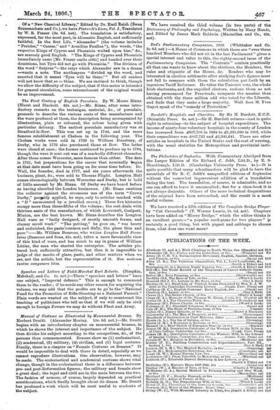The First Century of English Porcelain. By W. Moore Mune.
(Hurst and Blackett. 42s. net.)—Mr. Binns, after some intro- ductory remarks on the technique, material, &c., of porcelain, proceeds to describe the various seats of the manufacture and the ware produced at them, the description being accompanied by illustrations, plain or coloured, the colour being given with particular delicacy. The earliest porcelain manufactory was at Stratford-le-Bow. This was set up in 1744, and the more famous establishment at Chelsea in the following year. The Chelsea works were sold in 1769 to William Duesbury, of Derby, who in 1776 also purchased those at Bow. The latter were closed at once ; the former continued to produce up to 1784, though the ware it sent out was of a markedly different character. After these comes Worcester, more famous than either. The date is 1751, but preparations for the career that nominally began at that date must have been going on for some time before. Dr. Wall, the founder, died in 1777, and six years afterwards the business, plant, &c., were sold to Thomas Flight. Longton Hall comes chronologically between Worcester and Derby, but is held of little account by Mr. Binns. Of Derby we have heard before as having absorbed the London businesses. (Mr. Mans cautions the collector against the erroneous use of the term " Crown Derby," properly applied, he says, only to articles marked with a "D" surmounted by a jewelled crown.) These five histories occupy more than three-fifths of the volume ; the rest deals with thirteen seats of the manufacture, of which Lowestoft, Coalport, Minton, are the best known. Mr. Binns describes the Longton Hall ware as " badly designed, of mostly uncouth forms, and clumsy scroll work." "The potting," he goes on, "was heavy and unfinished, the paste.common and dirty, the glaze thin and poor."—Mr. William Bemrose, who writes Longton Hall Porce- lains (Bemrose and Sons, 42s. net), takes a more favourable view of this kind of ware, and has much to say in praise of William Littler, the man who started the enterprise. The articles pic- tured look sufficiently attractive, but then it is impossible to judge of the merits of glaze, paste, and other matters when we see, not the article, but the representation of it. Non nostrum tantas componere Wes.










































 Previous page
Previous page